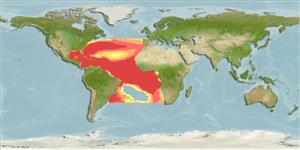Classificação / Names
Common names from other countries
Referência principal
Tamanho / Peso / Idade
Max length : 254 cm FL macho/indeterminado; (Ref. 40637); common length : 165 cm OT macho/indeterminado; (Ref. 43); Peso máx. publicado: 58.0 kg (Ref. 40637)
Ambiente
; marinhas; oceanódromo (Ref. 51243); intervalo de profundidade 0 - 200 m (Ref. 43), usually 100 - ? m (Ref. 4770)
Clima / Intervalo
Subtropical, preferred 26°C (Ref. 107945); 44°N - 33°S, 98°W - 17°E (Ref. 43)
Distribuição
Atlantic Ocean: widely distributed in offshore waters, much more densely so in the western than in the eastern Atlantic. Highly migratory species, Annex I of the 1982 Convention on the Law of the Sea (Ref. 26139).
Países | Áreas FAO | Ecossistemas | Ocorrências | Introduções
Descrição breve
Espinhos dorsais (total): 0; Raios dorsais moles (total): 50-57; Espinhos anais 0; Raios anais moles: 18 - 21; Vértebras: 24. Blue-black above, silvery white splattered with brown on the sides, silvery white below; dorsal fins dark blue; pectorals blackish brown, occasionally with tinges of greyish white; pelvic fins blue-black with a black fin membrane; 1st anal fin dark blue with silvery white at base; 2nd anal fin blackish brown.
Categoria na Lista Vermelha da IUCN (Ref. 115185)
Ameaça para o homem
Harmless
Utilização humana
Pescarias: pouco comercial; peixe desportivo: sim
Mais informação
ReferênciasAquaculturaPerfil para aquaculturaEstirpesGenéticaFrequência dos alelosHereditariedadeDoençasProcessamentoMass conversion
ColaboradoresFotografiasStamps, CoinsSonsCiguateraVelocidadeTipo de nataçãoÁrea branquialOutras referênciasCérebrosVisão
Ferramentas
Relatórios especiais
Descarregue XML
Fontes da internet
Estimates of some properties based on models
Phylogenetic diversity index
PD50 = 0.5630 many relatives (e.g. carps) 0.5 - 2.0 few relatives (e.g. lungfishes)
Nível Trófico
4.4 ±0.4 se; Based on diet studies.
Resiliência
Médio, tempo mínimo de duplicação da população 1,4 - 4,4 anos (Assuming tm=2-4)
Vulnerabilidade
Moderate to high vulnerability (49 of 100)
Categoria de preço
